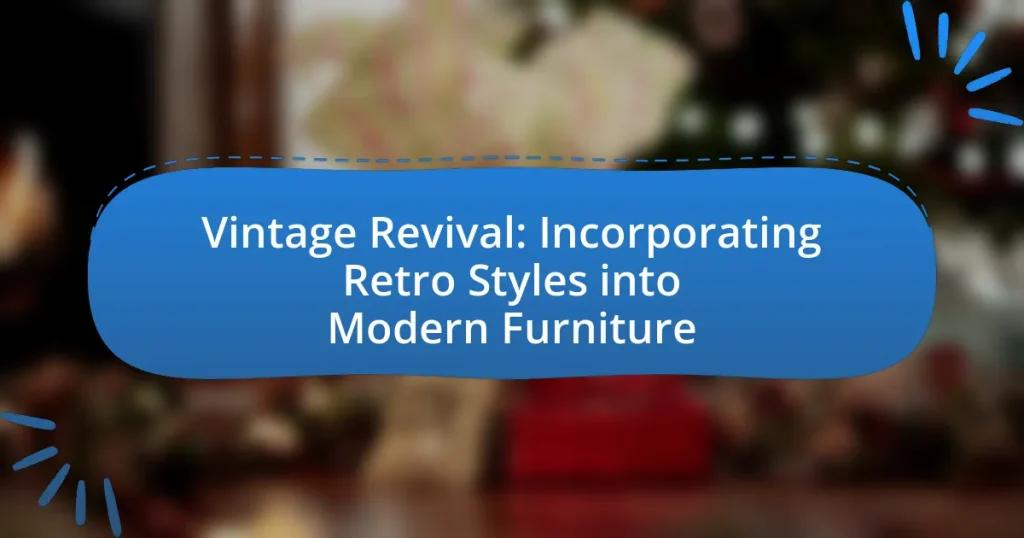Vintage Revival in furniture design is a trend that reintroduces and reinterprets styles from past decades, particularly the mid-20th century, emphasizing retro materials, colors, and forms while blending them with contemporary functionality. This movement is driven by consumer interest in sustainability and nostalgia, leading to a resurgence in demand for vintage-inspired furniture that reflects historical design elements. Key characteristics of vintage styles include bold colors, intricate patterns, and unique textures, which are integrated into modern designs to create a distinctive aesthetic. The article explores the influence of various retro styles, the cultural factors contributing to the vintage revival trend, and practical tips for successfully incorporating vintage elements into modern spaces.

What is Vintage Revival in Furniture Design?
Vintage Revival in furniture design refers to the trend of reintroducing and reinterpreting styles and aesthetics from past decades, particularly the mid-20th century. This movement emphasizes the use of retro materials, colors, and forms, often blending them with contemporary functionality. The popularity of Vintage Revival is supported by consumer interest in sustainable practices, as many vintage pieces are refurbished or repurposed, reducing waste. Additionally, the nostalgic appeal of vintage styles resonates with consumers, leading to a resurgence in demand for furniture that reflects historical design elements.
How does Vintage Revival influence modern furniture styles?
Vintage Revival significantly influences modern furniture styles by reintroducing design elements from past decades, particularly the mid-20th century. This revival emphasizes the use of bold colors, organic shapes, and unique materials, which were hallmarks of vintage designs. For instance, the resurgence of Scandinavian minimalism and the incorporation of retro patterns in upholstery reflect a direct lineage to vintage aesthetics. Additionally, the popularity of sustainable practices in furniture production aligns with the vintage ethos of quality craftsmanship and timeless design, as seen in the enduring appeal of pieces from iconic designers like Eames and Saarinen. This blend of nostalgia and modern functionality creates a distinctive style that resonates with contemporary consumers seeking both style and sustainability.
What are the key characteristics of vintage styles?
Vintage styles are characterized by their nostalgic aesthetic, often reflecting design trends from the early to mid-20th century. These styles typically feature bold colors, intricate patterns, and unique textures, which evoke a sense of history and charm. For instance, furniture pieces may showcase ornate detailing, tapered legs, and materials like wood and metal that were prevalent in past eras. Additionally, vintage styles often incorporate elements such as floral prints, geometric shapes, and retro color palettes, which are reminiscent of specific decades, such as the 1950s or 1970s. This connection to historical design not only enhances the visual appeal but also adds a layer of storytelling to modern interiors.
How do these characteristics translate into modern designs?
The characteristics of vintage styles translate into modern designs through the integration of retro aesthetics, materials, and functionality. Modern furniture often incorporates bold colors, geometric shapes, and nostalgic patterns reminiscent of mid-20th century design, appealing to contemporary consumers’ desire for uniqueness and personality in their spaces. For instance, the resurgence of materials like wood and metal, combined with sleek lines and minimalist forms, reflects the enduring influence of vintage design principles. This blending of old and new not only enhances visual appeal but also promotes sustainability by repurposing classic styles, as seen in the popularity of upcycled furniture that retains vintage charm while meeting modern standards.
Why is there a growing interest in retro styles?
There is a growing interest in retro styles due to a combination of nostalgia, sustainability, and the unique aesthetic appeal they offer. Nostalgia plays a significant role as consumers seek to reconnect with the past, often driven by memories associated with specific eras, such as the mid-20th century. This emotional connection is supported by research indicating that nostalgia can enhance mood and well-being, making retro styles particularly attractive. Additionally, the sustainability movement encourages the use of vintage and retro items, as they promote recycling and reduce waste compared to new production. The unique aesthetic of retro designs, characterized by bold colors and distinctive shapes, also appeals to modern consumers looking for individuality in their home decor. This trend is reflected in market data showing increased sales of vintage-inspired furniture and decor, indicating a clear shift towards retro styles in contemporary design.
What cultural factors contribute to the vintage revival trend?
The vintage revival trend is primarily influenced by nostalgia, sustainability, and the desire for individuality. Nostalgia drives consumers to seek items that evoke memories of past eras, often associated with perceived simplicity and authenticity. This emotional connection is supported by the rise of social media platforms, where vintage aesthetics are celebrated and shared, reinforcing cultural appreciation for retro styles. Sustainability plays a crucial role as well, with consumers increasingly valuing second-hand goods as environmentally friendly alternatives to mass-produced items. This shift is evidenced by a 2021 report from ThredUp, which indicated that the second-hand market is projected to reach $64 billion by 2024, highlighting a growing preference for vintage and pre-owned items. Lastly, the quest for individuality leads consumers to embrace unique vintage pieces that stand out in a world of uniformity, further fueling the trend.
How does nostalgia play a role in furniture choices?
Nostalgia significantly influences furniture choices by driving consumers to seek designs that evoke memories of past eras. This emotional connection often leads individuals to prefer vintage or retro styles, as these pieces can remind them of their childhood or significant life events. Research indicates that nostalgia can enhance consumer satisfaction and increase the likelihood of purchasing items that reflect personal history or cultural heritage. For instance, a study published in the Journal of Consumer Research found that nostalgic feelings can lead to a preference for products that symbolize a connection to the past, thereby affecting buying behavior in the furniture market.

What are the Different Retro Styles Incorporated into Modern Furniture?
Different retro styles incorporated into modern furniture include Mid-Century Modern, Art Deco, and Industrial styles. Mid-Century Modern, characterized by clean lines and organic forms, gained popularity in the 1940s to 1960s and is often reflected in contemporary furniture through the use of natural materials and minimalist designs. Art Deco, which emerged in the 1920s and 1930s, is recognized for its bold geometric patterns and luxurious materials, influencing modern furniture with its emphasis on glamour and elegance. Industrial style, rooted in the early 20th century, incorporates raw materials like metal and wood, often seen in modern furniture that embraces a rustic yet urban aesthetic. These styles are validated by their continued presence in design trends and consumer preferences, showcasing a blend of nostalgia and contemporary functionality.
Which decades are most influential in vintage furniture design?
The most influential decades in vintage furniture design are the 1950s, 1960s, and 1970s. The 1950s introduced mid-century modern design characterized by clean lines, organic forms, and functional aesthetics, with designers like Charles and Ray Eames leading the movement. The 1960s saw the rise of bold colors and experimental shapes, influenced by pop culture and the Space Age, with iconic pieces from designers such as Verner Panton. The 1970s embraced eclectic styles, incorporating natural materials and earthy tones, reflecting a shift towards sustainability and a connection to nature. These decades collectively shaped the foundation of contemporary vintage aesthetics, making them pivotal in the evolution of furniture design.
What defines the aesthetics of the 1950s furniture style?
The aesthetics of the 1950s furniture style are defined by clean lines, organic shapes, and a blend of functionality with playful design elements. This era emphasized minimalism and simplicity, often featuring materials like molded plywood, fiberglass, and metal, which contributed to a modern yet approachable look. Iconic pieces, such as the Eames Lounge Chair and the Saarinen Tulip Table, exemplify the era’s focus on both comfort and innovative design. The color palette typically included pastels and bold hues, reflecting the optimism of post-war America, while patterns often drew inspiration from nature and geometric forms.
How does the 1970s style differ from earlier designs?
The 1970s style differs from earlier designs primarily through its bold use of color, eclectic patterns, and a focus on comfort and functionality. Unlike the more restrained and formal aesthetics of the 1950s and 1960s, the 1970s embraced vibrant hues such as orange, avocado green, and mustard yellow, often combined in striking geometric or floral patterns. Additionally, furniture from this era featured low-profile designs, plush upholstery, and an emphasis on casual living, reflecting the cultural shifts towards more relaxed lifestyles. This shift is evidenced by the popularity of items like bean bag chairs and modular sofas, which contrasted sharply with the more rigid forms of previous decades.
What types of materials are commonly used in vintage-inspired furniture?
Common materials used in vintage-inspired furniture include wood, metal, leather, and upholstery fabrics. Wood, particularly types like oak, walnut, and teak, is favored for its durability and classic aesthetic, often seen in mid-century modern designs. Metal, especially wrought iron and brass, adds an industrial touch and is frequently used in frames and accents. Leather is utilized for its timeless appeal and comfort, while upholstery fabrics such as velvet and linen are chosen for their vintage textures and patterns, enhancing the retro look. These materials collectively contribute to the nostalgic charm and authenticity of vintage-inspired furniture.
How do wood finishes reflect retro styles?
Wood finishes reflect retro styles by emphasizing natural textures and warm tones that were popular in mid-20th century design. These finishes often include matte or satin sheens, which evoke a sense of nostalgia and authenticity, reminiscent of the furniture produced during the 1950s and 1960s. For example, walnut and teak finishes are commonly used to replicate the aesthetic of that era, as they were favored for their rich colors and grain patterns. Additionally, techniques such as distressing or using oil-based finishes can enhance the vintage appeal, aligning with the trend of creating pieces that feel both timeless and historically rooted.
What role do fabrics and patterns play in vintage revival furniture?
Fabrics and patterns are essential in vintage revival furniture as they evoke nostalgia and authenticity associated with specific historical periods. These elements help to recreate the aesthetic and emotional appeal of past design trends, making modern furniture feel timeless and connected to history. For instance, the use of bold floral patterns or geometric designs reminiscent of the 1960s and 1970s can transform a contemporary piece into a statement that reflects the charm of that era. Additionally, materials like velvet or tweed, commonly used in vintage furniture, enhance tactile experiences and visual richness, further bridging the gap between past and present styles.

How Can You Successfully Incorporate Vintage Styles into Modern Spaces?
To successfully incorporate vintage styles into modern spaces, blend vintage furniture pieces with contemporary decor to create a cohesive aesthetic. For instance, pairing a mid-century modern chair with a sleek, minimalist table can highlight the unique characteristics of both styles. Historical data shows that the mid-century modern design movement, which peaked from the 1940s to the 1960s, emphasizes functionality and simplicity, making it a versatile choice for modern interiors. Additionally, using vintage accessories, such as retro lamps or artwork, can add character without overwhelming the space. This approach not only honors the charm of vintage design but also enhances the overall modern ambiance.
What are some practical tips for blending vintage and modern furniture?
To effectively blend vintage and modern furniture, start by selecting a cohesive color palette that harmonizes both styles. This approach ensures that the different pieces complement each other visually. For instance, pairing a modern sofa in a neutral tone with vintage accent chairs in similar shades creates a unified look. Additionally, mix textures by combining sleek modern materials, such as metal or glass, with the warmth of vintage wood or fabric. This contrast enhances the overall aesthetic.
Incorporating statement pieces, like a bold vintage coffee table, can serve as a focal point in a modern setting, drawing attention and creating interest. Furthermore, maintaining balance is crucial; avoid overcrowding a space with too many contrasting styles. Instead, allow each piece to stand out by providing adequate space around them.
Lastly, consider the scale of the furniture; ensure that the sizes of vintage and modern pieces are proportionate to each other and the room. This attention to scale helps maintain a harmonious flow throughout the space.
How can color schemes enhance the vintage-modern mix?
Color schemes can enhance the vintage-modern mix by creating a cohesive visual narrative that bridges the gap between retro aesthetics and contemporary design. By selecting colors that reflect both eras, such as muted pastels or rich jewel tones, designers can evoke nostalgia while maintaining a fresh, modern appeal. For instance, a combination of soft mint green with deep navy can highlight vintage elements like mid-century furniture while ensuring the overall look feels current. This strategic use of color not only emphasizes the unique characteristics of vintage pieces but also integrates them seamlessly into modern spaces, making the design more relatable and visually engaging.
What furniture pieces work best for a vintage revival look?
Furniture pieces that work best for a vintage revival look include mid-century modern chairs, retro coffee tables, and vintage sideboards. Mid-century modern chairs, characterized by their clean lines and organic shapes, often feature materials like teak and molded plastic, making them iconic for this style. Retro coffee tables, particularly those with chrome or glass elements, evoke the playful aesthetics of the 1950s and 1960s. Vintage sideboards, often crafted from rich woods and adorned with unique hardware, serve as functional storage while adding a nostalgic charm to contemporary spaces. These pieces not only reflect historical design trends but also complement modern interiors, creating a cohesive vintage revival aesthetic.
What common mistakes should be avoided when mixing styles?
When mixing styles, one common mistake to avoid is failing to establish a cohesive color palette. A disjointed color scheme can create visual chaos, making the space feel unbalanced. For instance, using clashing colors from different eras can detract from the intended aesthetic, as seen in design principles that emphasize harmony and unity. Another mistake is neglecting scale and proportion; combining oversized vintage pieces with delicate modern furniture can lead to an awkward arrangement. Properly considering the scale ensures that each element complements the others, maintaining a harmonious flow in the space. Lastly, overlooking the importance of texture can result in a flat design; incorporating various materials, such as wood, metal, and fabric, enhances depth and interest, aligning with the principles of successful interior design.
How can over-cluttering affect the aesthetic balance?
Over-cluttering disrupts aesthetic balance by overwhelming visual harmony and creating chaos in a space. When too many items compete for attention, it diminishes the impact of individual pieces, particularly in vintage and retro styles that rely on simplicity and focal points to convey their charm. Research indicates that environments with excessive clutter can lead to increased stress and decreased satisfaction, as noted in a study published in the Journal of Environmental Psychology, which found that cluttered spaces can negatively affect mood and cognitive function. Therefore, maintaining a curated selection of vintage items enhances the overall aesthetic by allowing each piece to stand out and contribute to a cohesive design.
What should you consider regarding scale and proportion in design?
In design, particularly when incorporating retro styles into modern furniture, it is essential to consider scale and proportion to ensure harmony and functionality. Scale refers to the size of an object in relation to its surroundings, while proportion deals with the relationship between different elements within a design. For instance, a large vintage armchair may dominate a small room, making it feel cramped, whereas a well-proportioned piece can enhance the space. Historical design principles, such as the Golden Ratio, demonstrate that pleasing proportions can create visual balance and aesthetic appeal. Therefore, understanding these concepts is crucial for achieving a cohesive and inviting design that respects both vintage and modern elements.
What are the best practices for sourcing vintage-inspired furniture?
The best practices for sourcing vintage-inspired furniture include researching reputable dealers, attending estate sales and auctions, and utilizing online marketplaces. Reputable dealers often provide authenticity guarantees and detailed histories of the pieces, ensuring quality and value. Estate sales and auctions can yield unique finds at competitive prices, while online marketplaces like Etsy and eBay offer a wide range of vintage-inspired options from various sellers. Additionally, understanding the characteristics of different vintage styles, such as mid-century modern or art deco, helps in making informed purchasing decisions.
How can thrift stores and online marketplaces be utilized effectively?
Thrift stores and online marketplaces can be utilized effectively by strategically sourcing unique vintage items that enhance modern furniture designs. Shoppers should focus on identifying quality pieces that complement contemporary aesthetics, such as mid-century modern chairs or retro lamps, which can add character to modern spaces. Research indicates that vintage items not only provide distinct style but also promote sustainability by reducing waste, as noted in a study by the Journal of Consumer Research, which highlights the growing consumer preference for sustainable practices in home decor. By leveraging these platforms, individuals can find affordable, one-of-a-kind items that elevate their interior design while supporting eco-friendly consumption.
What should you look for in quality vintage reproductions?
When evaluating quality vintage reproductions, you should look for authenticity in design, craftsmanship, and materials. Authenticity in design means the reproduction closely resembles the original vintage piece in style, proportions, and details, reflecting the era it represents. Craftsmanship is crucial; high-quality reproductions are often handmade or exhibit superior construction techniques, such as dovetail joints or solid wood, rather than particle board. Additionally, the materials used should be durable and appropriate for the style, such as using real leather or high-quality fabrics instead of synthetic alternatives. These factors ensure that the reproduction not only looks good but also stands the test of time, similar to the original vintage items.


